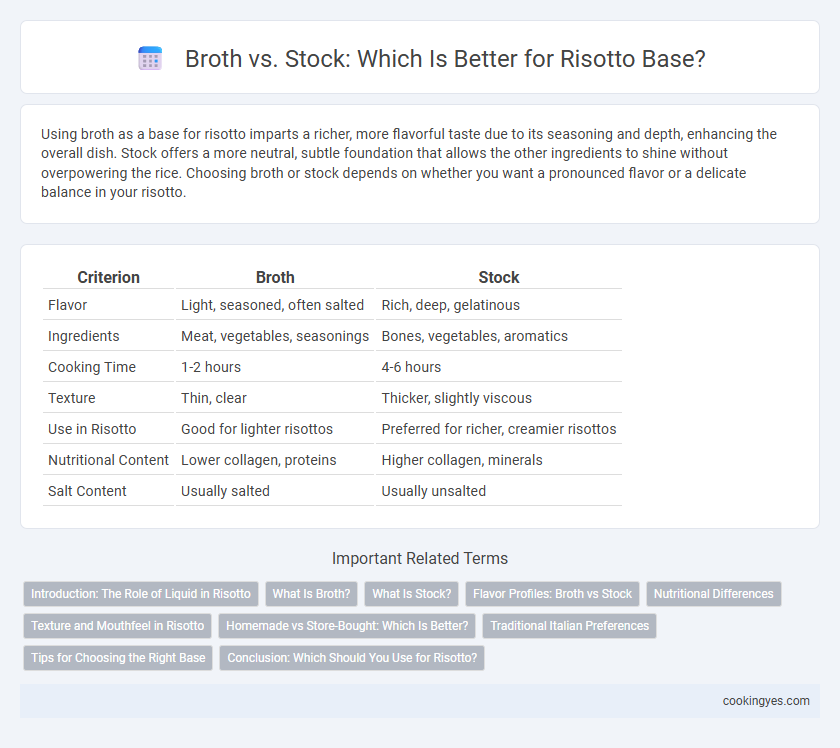Using broth as a base for risotto imparts a richer, more flavorful taste due to its seasoning and depth, enhancing the overall dish. Stock offers a more neutral, subtle foundation that allows the other ingredients to shine without overpowering the rice. Choosing broth or stock depends on whether you want a pronounced flavor or a delicate balance in your risotto.
Table of Comparison
| Criterion | Broth | Stock |
|---|---|---|
| Flavor | Light, seasoned, often salted | Rich, deep, gelatinous |
| Ingredients | Meat, vegetables, seasonings | Bones, vegetables, aromatics |
| Cooking Time | 1-2 hours | 4-6 hours |
| Texture | Thin, clear | Thicker, slightly viscous |
| Use in Risotto | Good for lighter risottos | Preferred for richer, creamier risottos |
| Nutritional Content | Lower collagen, proteins | Higher collagen, minerals |
| Salt Content | Usually salted | Usually unsalted |
Introduction: The Role of Liquid in Risotto
The quality of the broth or stock is crucial in developing the creamy texture and rich flavor characteristic of authentic risotto. Broth, typically lighter and seasoned, enhances the rice with subtle savory notes, while stock, made from simmered bones and vegetables, provides a deeper, more gelatinous body that intensifies the dish's complexity. Selecting between broth and stock directly influences the final taste profile and mouthfeel, making the choice of liquid a foundational step in mastering risotto.
What Is Broth?
Broth is a flavorful, clear liquid made by simmering meat, vegetables, and herbs, often strained to create a balanced base for risotto. It contains a higher concentration of seasoning and lighter consistency compared to stock, enhancing the risotto's taste without overpowering the delicate rice texture. Using broth for risotto ensures a rich yet subtle depth of flavor that accentuates the dish's creamy finish.
What Is Stock?
Stock is a flavorful liquid made by simmering bones, vegetables, and aromatics for several hours, extracting gelatin and deep savory taste essential for a rich risotto base. Unlike broth, stock typically does not contain added seasoning, allowing chefs to control salt levels and balance flavors precisely during cooking. Using homemade or high-quality stock enhances the creamy texture and depth of a classic risotto dish.
Flavor Profiles: Broth vs Stock
Broth offers a lighter, clearer flavor with subtle seasoning, enhancing the delicate texture of risotto without overpowering its creamy richness. Stock provides a richer, more gelatinous base extracted from simmered bones, delivering deeper umami and mouthfeel that intensifies the dish's overall savory depth. Choosing broth or stock directly influences the risotto's complexity, balancing between a refined, gentle taste and a robust, hearty foundation.
Nutritional Differences
Broth and stock differ nutritionally in risotto preparation, as broth typically contains more sodium and sometimes added seasonings, while stock offers richer collagen and minerals from prolonged simmering of bones. Broth is often lighter with fewer calories but less gelatin, affecting the texture and mouthfeel of the risotto. Choosing stock enhances protein content and supports a creamier consistency, contributing to a more nutrient-dense base for the dish.
Texture and Mouthfeel in Risotto
Broth provides a lighter texture and more delicate mouthfeel in risotto, allowing the rice's creaminess to stand out, while stock offers a richer, deeper flavor that can result in a heartier, more robust mouthfeel. The gelatin content in stock enhances the risotto's velvety consistency, creating a luxurious, smooth finish that coats the palate. Choosing broth or stock significantly influences the overall texture and sensory experience of the risotto, balancing richness and subtlety.
Homemade vs Store-Bought: Which Is Better?
Homemade broth offers richer flavor and customized seasoning, enhancing the creamy texture and depth essential for perfect risotto. Store-bought broth provides convenience but often contains preservatives and lacks the nuanced taste that slow-simmered bones and vegetables impart. Using a high-quality homemade broth elevates the quality of risotto, delivering a more authentic and satisfying culinary experience.
Traditional Italian Preferences
Traditional Italian risotto recipes favor broth over stock as the base for its delicate flavor and clarity. Broth, typically made by simmering meat, vegetables, and herbs briefly, imparts a light yet rich taste that complements risotto's creamy texture without overpowering it. In contrast, stock's longer cooking time extracts gelatin and deeper flavors, which can muddy the subtle balance essential in authentic risotto dishes.
Tips for Choosing the Right Base
Choose broth with a rich, well-seasoned flavor to enhance the creamy texture of risotto, as it intensifies the rice's natural taste while providing a balanced umami depth. Opt for homemade or high-quality store-bought broth over stock to maintain a lighter texture that won't overpower the dish, ensuring each grain of Arborio rice absorbs optimal moisture and flavor. Incorporate hot broth gradually, allowing the risotto to release starch gently, which results in a velvety consistency essential for authentic risotto.
Conclusion: Which Should You Use for Risotto?
For risotto, broth is typically preferred over stock because it offers a clearer, more refined flavor that enhances the delicate texture of the rice without overpowering it. Broth, often seasoned and made from simmered meat or vegetables, integrates seamlessly into the risotto, while stock's richer, gelatinous consistency can sometimes weigh down the final dish. Choosing broth results in a balanced, flavorful base that allows the other ingredients to shine.
Broth vs stock for risotto base Infographic

 cookingyes.com
cookingyes.com